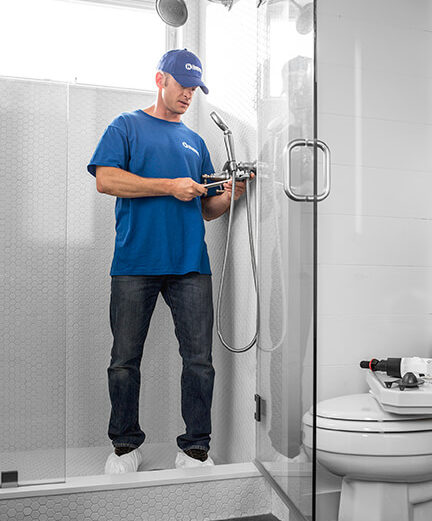We offer a wide range of services for that fresh look, or just maintenance or updates to keep your home functioning and safe. Regardless of the size of the job, we have a craftsman that can tackle it. We offer a wide range of services for that fresh look, or just maintenance or updates to keep your home functioning and safe. Regardless of the size of the job, we have a craftsman that can tackle it.

Electrical / November 12, 2024

Homeowners often overlook the silent yet critical role that electrical systems play in their daily lives. As the backbone of modern convenience, a reliable electrical setup not only powers our devices but also ensures safety within our homes.
However, the condition and quality of these systems can vary widely based on when a house was built. Understanding the timeline of your home’s construction can be pivotal when considering electrical services in Ottawa, particularly when it comes to rewiring old houses and upgrading outdated electrical systems.
Does it matter when your house was built when it comes to your home’s rewiring? Absolutely. Homes constructed several decades ago often feature wiring that no longer meets current safety standards or can support the demands of today’s technology. Handyman Connection in Ottawa specializes in addressing these concerns, offering expert advice and services tailored to the unique needs of older properties.
As we explore the importance of rewiring, we will dig into the potential hazards of outdated electrical systems, the benefits of timely upgrades, and the peace of mind that comes with knowing your home is safe and functional.
Over the past few decades, electrical standards have seen significant advancements, reflecting the rapid evolution of technology and a growing awareness of safety issues. These improvements are crucial for today’s homes, as they ensure that electrical systems can meet modern demands while prioritizing safety and efficiency.
Key advancements include:
Common reasons for technological upgrades in newer homes include:
As technology continues to evolve, so does the need for modern services that enhance safety and functionality within homes. Keeping abreast of these advancements and understanding the common triggers for upgrades is essential for any homeowner looking to maintain a safe and efficient environment.
Homes built during the 1970s and 1980s often present unique challenges when it comes to electrical systems. Many standards from this period have since been updated, and certain materials used can pose safety risks. It is essential to understand these changes, as well as the importance of modernizing outdated infrastructure to meet today’s electrical demands.
Key Changes and Common Issues:
Given the advancements in technology and increased demand for electricity in modern homes, updating systems from this era is crucial for ensuring safety and functionality. By addressing these common issues and aligning with contemporary electrical codes, homeowners can significantly reduce risks and enhance the efficiency of their homes.

If your house was built in the 1950s or 1960s, it’s likely part of the transition from fuse boxes to circuit breakers. Circuit breakers are far more reliable and offer enhanced protection against electrical overloads. Making this upgrade is an important step in safeguarding your home from potential hazards.
Ungrounded systems were also prevalent during this period, posing various risks, including electrical shocks and fire hazards. Ensuring that your home’s wiring is grounded is essential for modern safety standards.
Furthermore, the materials used in older setups can degrade over time, increasing the risk of failure. By replacing old components, you can prevent potential dangers and upgrade the overall performance of your wiring.
For those living in homes built in the early 20th century, electrical configurations can be quite outdated. Knob-and-tube wiring was commonly used during this period, and it was known for its limited capacity and lack of grounding.
Rewiring properties from this era is often critical for meeting safety standards. Not only does this old-fashioned wiring pose serious risks, but it also fails to support the electrical demands of today’s technology-driven world.
Complete rewiring is typically necessary for these homes, replacing outdated materials with modern solutions that are safer and more efficient. It’s an investment that not only brings peace of mind but also enhances the value and functionality of the property.
Understanding the era in which your house was built is essential when determining your rewiring needs. Each decade brought different safety standards and electrical technologies that influence the type of wiring and electrical fixtures in your home. By acknowledging these variations, homeowners can better identify potential hazards and the necessity for upgrades. Our team at Handyman Connection is well-versed in these historical nuances, allowing us to provide tailored electrical services in Ottawa that address every unique situation effectively.
We recognize that rewiring old houses is not merely about complying with codes; it’s about ensuring safety and functionality in our homes. Upgrading old electrical systems is paramount to support the demands of modern life and technology. With the expertise of Handyman Connection, homeowners can rest assured that their properties will not only meet current standards but will also accommodate future advancements in wiring technology.
In conclusion, investing in the right electrical updates is crucial for the safety and efficiency of your home. Don’t overlook the importance of your home’s construction era when considering rewiring projects. Reach out to us at Handyman Connection in Ottawa to learn more. Request an estimate today and discover how our comprehensive services can help keep your home safe and modern with expert rewiring solutions.